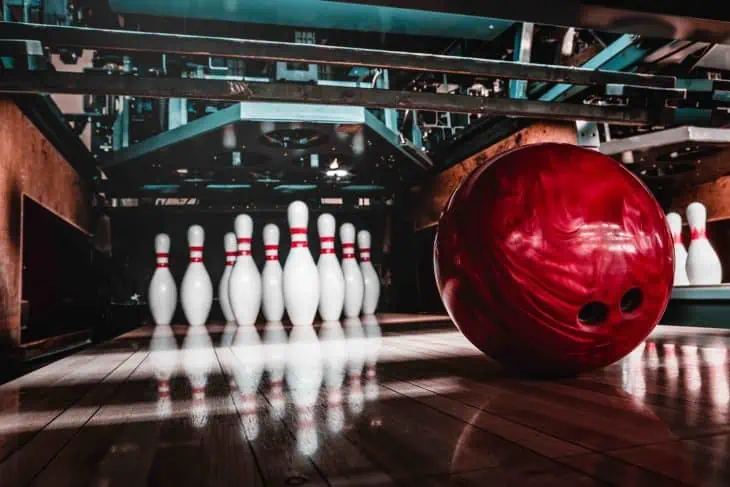
Bowling is more than just a competitive sport. It is also a fun and easy hobby to learn. As with any sport, it might be confusing at first, especially since there are so many different bowling terms you need to know. However, believe us, once you get the basics down, you’ll be able to follow any bowling game like a pro.
Before diving into the different terms used in bowling, it is important to first understand the game itself.
What is Bowling?
Bowling is a type of target sport. A target sport involves the player throwing an object toward a specific area or point. There are two types of bowling: target bowling and pin bowling.
In target bowling, the player throws a bowling ball toward a target or mark. The goal is to get the ball as close to the target as possible. People play target bowling on different surfaces, such as grass or gravel.
In pin bowling, the player throws a bowling ball toward a set of pins to knock them down. The goal is to knock over as many pins as possible. This type is more common and well-known than target bowling.
There are many types of pin bowling. There are also nine-pin, five-pin, duckpin, candlepin, and kegel bowling. The most popular type of pin bowling is ten-pin bowling, where there are ten pins lined up for the player to knock over.
When people say “bowling,” they are usually referring to ten-pin bowling. The same goes for this article, which will focus on the bowling terms, slang, and equipment used in ten-pin bowling.
History of Bowling
Today, bowling is more than just a popular sport. It is a fun pastime that people of all genders, ages, and skills can enjoy. It is also a game that you can play together with your friends and family. Back then, however, bowling differed greatly from what you see today.
The question “when was bowling invented?” yields a lot of interesting answers. One of the earliest records of bowling was found in Ancient Egypt. In an Egyptian tomb dating back to 3200 B.C., historians discovered nine pieces of stone set up as pins, a stone “ball,” and a marble archway. They concluded the setup was a version of bowling, where players threw the stone ball through the marble archway and hit the nine stone “pins.”
Another historical account for bowling comes from Ancient Germany. Ancient Germans performed a religious ceremony similar to modern-day bowling. Parishioners placed a pin or “kegel” at the end of a runway. They rolled a stone down the lane to knock the pin down. The fallen pin represented the cleansing of their sins.
Over the centuries, the sport continued to develop until it became popular in North America. By then, Europeans had come up with their own rules for the sport. However, New Yorkers questioned these rules, so they formed the American Bowling Congress (ABC) in 1895. Together, they developed standardized rules and equipment for bowling that people continue to follow.
Today, the United States Bowling Congress (USBC) is the official governing body of bowling in the United States.
Basic Rules of Bowling
To better understand the different bowling terms, it is important to first understand the rules well. Here are some of the basic bowling rules every beginner should know about.
Wear the proper attire.
It is best to wear clothes you feel comfortable moving in. When bowling, consider wearing a loose shirt and jeans.

The most important part of the attire is the bowling shoes. Bowling alleys will require you to wear proper bowling shoes before entering the area. Bowling shoes differ from regular shoes as they are made from materials that will not damage the lanes. Most establishments won’t lend you shoes if you aren’t wearing socks for hygienic purposes. While some bowling centers also sell socks, it is better to come in with your own socks just to be sure.
Do not cross the foul line.
This is one of the bowling rules that you’ll want to keep in mind during the whole match. Players are very strict with this rule in particular. Crossing the foul line during your throw will result in a score of zero. To avoid wasting any throws, be sure to throw the ball before the foul line.
A player cannot alter their ball mid-match.
Once a match starts, a player can no longer polish or wipe their bowling ball. Doing otherwise might lead to the player’s disqualification. This is to prevent people from cheating by adding polish or oil that would make their bowling ball shinier or rougher according to the condition of the lane. Players, however, are free to polish or change their bowling balls in between games.
Any pins that a bowl from the gutter knocks over are no longer valid.
Sometimes, a gutter ball might bounce back onto the lane. When this happens, it might also knock down more pins. However, once a bowling ball falls into the gutter, the player’s throw ends. This means that any succeeding pins that the gutter ball manages to knock over by chance are no longer counted in the score.
The first player on the approach gets to play first.
When more than one player steps forward to play, the players are all expected to give way to the first one who stepped on the approach. This isn’t exactly a strict rule in bowling. However, it is proper bowling etiquette.
In case the players are not sure who stepped up to the approach first, then the player on the right goes first.
With the basic rules of bowling down, it is now time to learn the different bowling terms and definitions. If you’re looking for a list that compiles the basic bowling terms for scoring, equipment, and gameplay, then you came to the right place!
Common Bowling Terms
Since bowling is a popular sport, there are a lot of terms that people pick up on just from casually playing or from watching movies or TV shows. Here are some common bowling terms everybody should know about.
Bowling Ball
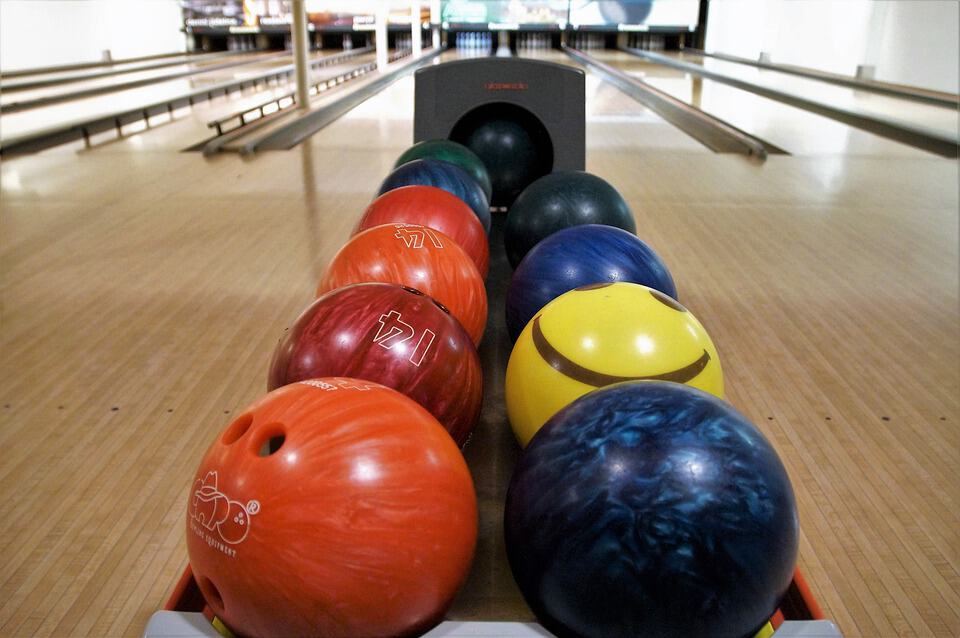
One of the easiest bowling terms to learn is the bowling ball. A bowling ball for ten-pin bowling has three holes on top. These holes are where the players insert their pointer and middle fingers and thumb so that they can have a better grip on the ball. Compared to balls used in other sports, a bowling ball is much heavier.
However, there are different sizes, weights, and designs. Bowling balls for kids will weigh much lighter than those for adults. They also vary in material, such as polyester and resin balls. Seasoned bowling players have their own collection of customized balls they feel most comfortable using.
Pins
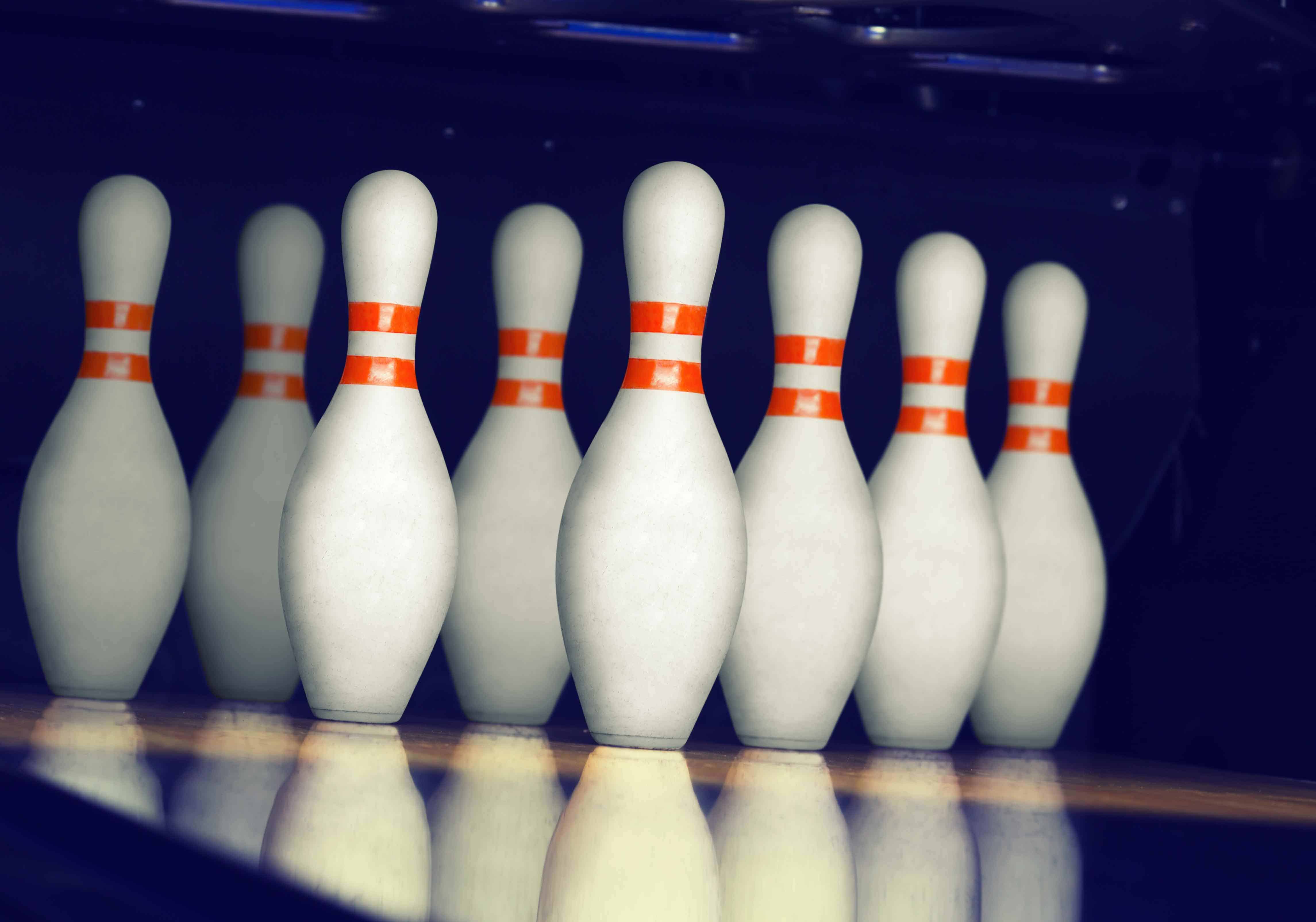
In bowling terms, a pin refers to the white club-shaped objects at the end of the lane. These pins usually have two red stripes around their necks. Other names for bowling pins include “skittles” and “kegels.”
Many often wonder how many pins in bowling are necessary to play a game. This answer differs for each type of bowling. For ten-pin bowling, you will obviously need ten pins. The standard size for ten-pin bowling pins is 15 inches tall and 4.75 inches wide at its base. Its average weight is 3 pounds and 8 ounces.
Pins have corresponding numbers. The center pin or headpin stands at the very front, and this is number 1. In the second row are the numbers 2 and 3, with 2 on the left. From left to right, the third row has the pins numbered 4, 5, and 6. Pin 5 is also known as the king pin or kingpin. The fourth and last row has pins 7, 8, 9, and 10.
House

When bowling players ask you to meet them at the “house,” they don’t actually mean their own home. In bowling terms, a house refers to the bowling establishment or building that houses the bowling alley.
House Ball
One of the most common bowling terms you’ll hear often is the house ball. A house ball refers to any ball that the house or bowling alley provides. These are usually what first-time and casual bowling players use as they do not have their personal bowling ball.
If you do not have your own bowling ball, you will need to rent a house ball for your game. Bowling alleys will have house balls in different sizes and colors, so you’ll find a great fit for you for sure!
Gutter
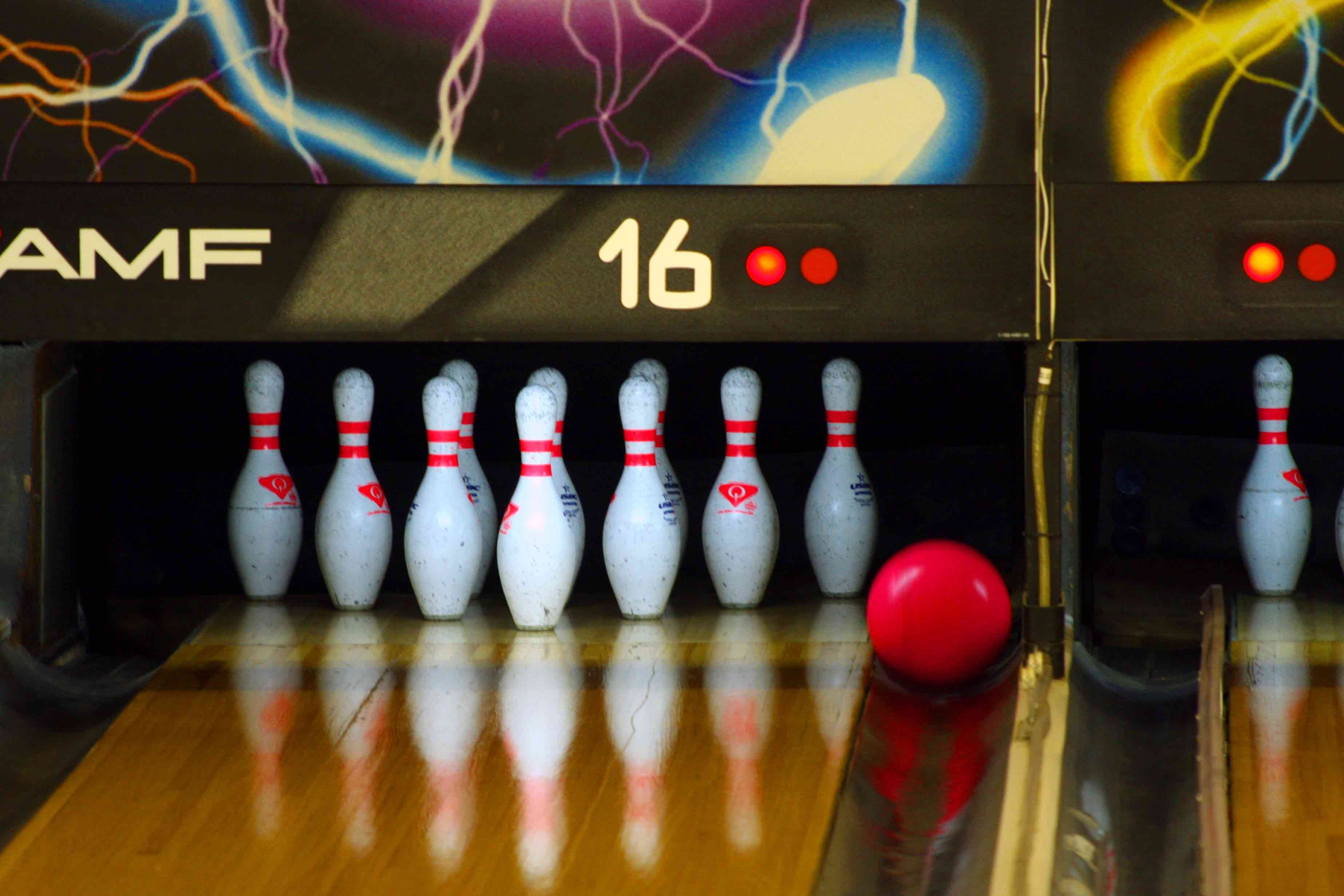
The word, “gutter,” has a lot of meanings. One of its most common definitions is the trough attached to your rooftop, collecting and redirecting rainwater to a channel downward. This is similar to the “gutter” in bowling terms.
At a bowling alley, you’ll notice that each lane has one groove on either side. This is called the gutter. When you throw a ball down the lane, the ball might roll off-center and into one of the gutters. This is something you want to avoid as the ball can no longer hit the pins once it lands in the gutter.
Other names for the gutter include “channel” and “moat.”
Strike
One of the most popular bowling terms is “strike.” In bowling, a strike happens when you throw the ball and knock down all ten pins in one go. Both beginner and professional players all aim for a strike when throwing the ball in their first attempt. This is because it will give them a head start and a higher score. It is normally represented by an ‘X’ in the scoreboard.
Spare
A spare is the next best thing to a strike. A spare happens when the player manages to knock down all the pins after their second throw. This means that the first attempt knocked a few pins down with some remaining upright. The second attempt then knocked the remaining pins down.
It is represented by a ‘/’ in the scoreboard.
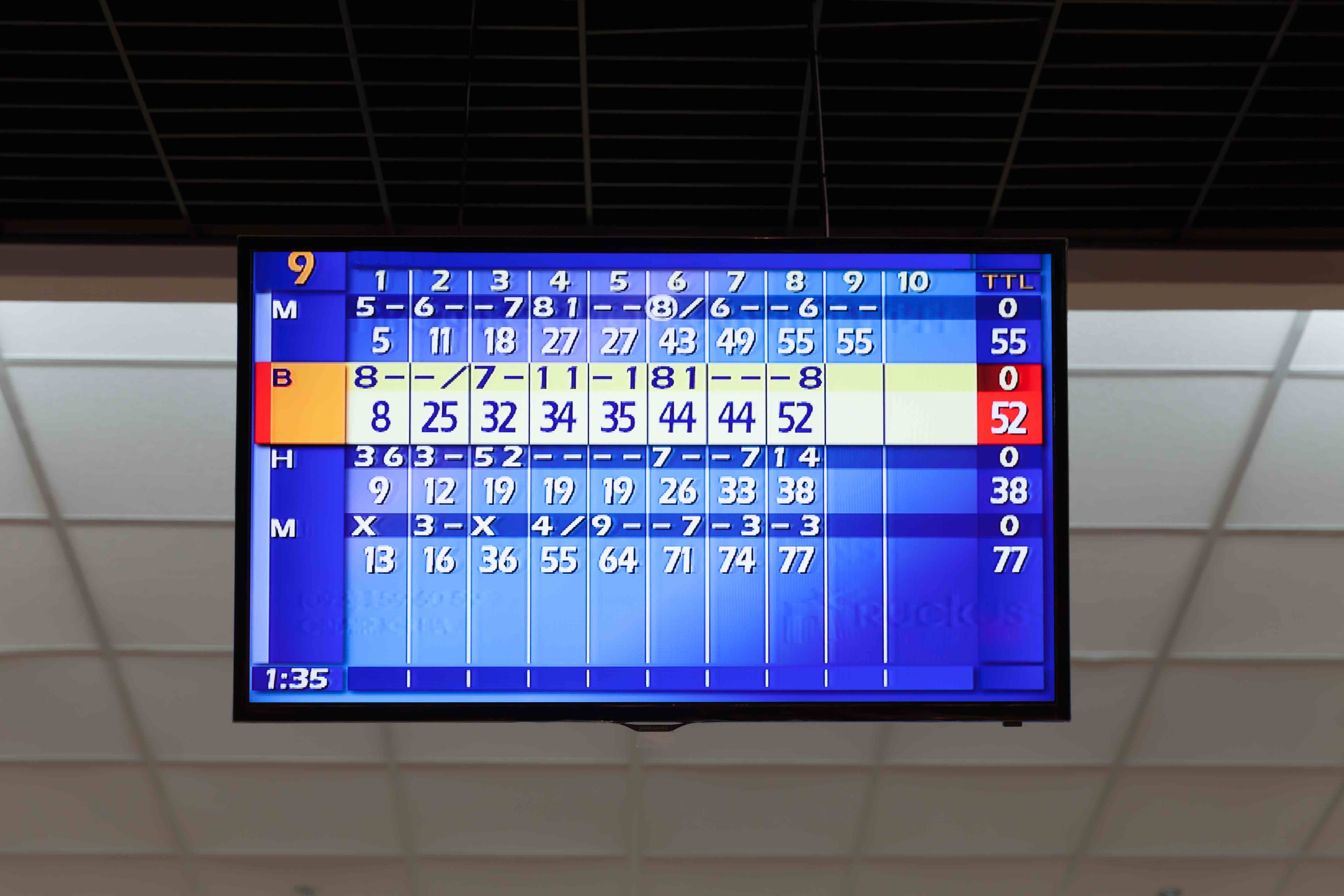
Perfect Game
In bowling terms, a “perfect game” occurs when the player manages to win by achieving a strike at every turn. This results in a score of 300, which is also the maximum score one can get in bowling.
A perfect game isn’t easy. In fact, even professional bowlers find it difficult to achieve a perfect game. Like with any sport, it will require a lot of practice and training.
Another name for a perfect game is “three hundred game.”
Open Bowling
When people play bowling for the fun of it, they are playing “open bowling.” Like most sports, bowling also has a competitive side. There are league and tournament plays professional bowlers take part in.
Outside of that, however, people can simply enjoy bowling with no pressure to compete. Open bowling is the recreational side of bowling, where players are not training or competing.
Match Play
On the other hand, match play refers to competitive bowling. In bowling terms, match play is a game between two players. They compete against one another in a 1-v-1 match. The winner gets to advance to the next round, where they will once again compete with another player. This goes on until two players are left to compete with one another in the final round.
Bowling Lane and Equipment Terms
The playing area and equipment in bowling are very unique. At first glance, it might be hard to name all the things you see in a bowling establishment. However, this list of bowling terms for lane and equipment will help you feel less confused.
Approach
In bowling terms, the word, “approach,” has two different meanings. First, approach can mean the area directly before the foul line. It is where the bowler walks forward to prepare for their throw. There are three dots there to help mark the approach for the player.
The second definition of approach is the walk or stride that the player makes toward the foul line. In other words, it is how the player approaches the lane to make their throw.
Arrows
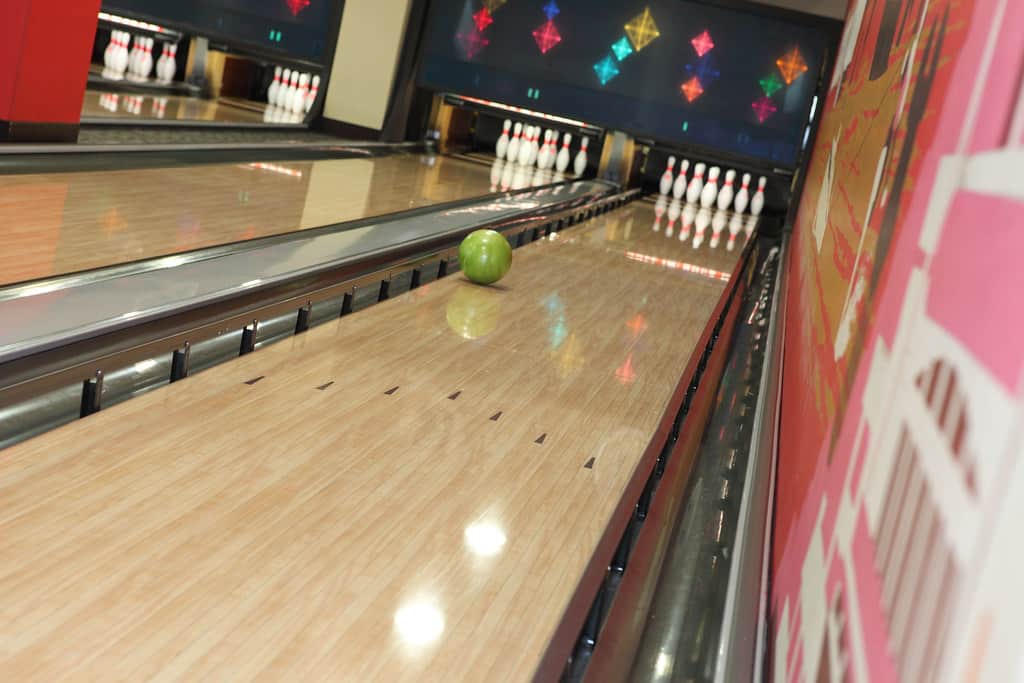
When you step up to the lane, you will notice some triangle markings on the floor. These are called “arrows.” The arrows help the bowler align themselves better by marking where they should aim their throw.
Beginners and professionals alike use these arrows to help them aim better, so don’t feel shy about using them to your advantage. That way, you have a better chance of scoring a strike!
Back End
As the name suggests, the farthest portion of the lane is the back end. The back end is the last 20 feet of the lane. It is where the most hook can occur. This means that the ball can curve toward a specific point or pin while it rolls down the back end.
However, it is important to ensure that the back end is properly conditioned. If the back end is too dry, the hook will most likely go astray. This leads to fewer chances of scoring a strike.
Ball Rack
In bowling terms, the ball rack refers to where the bowling balls are first kept before a player makes their turn. It is also where the ball rolls back to after it falls into the pit. The ball rack ensures that the bowling balls are organized. It also keeps the bowling balls near the player’s side for their turn.
Ball Return
The ball return is responsible for delivering the thrown ball back to the ball rack. It lies underneath the lane. This mechanism is very important. Without it, the thrown balls would end up stuck in the lane’s pit.
Ball Track
Another part of the lane is the ball track. The ball track refers to where the ball rolls down the lane. In simple terms, it comprises the majority of the lane. The ball track needs to be level so that thrown balls do not roll astray. A poorly built ball track that is not level will most likely result in uneven throws. Even a seasoned bowler will find it difficult to play on an uneven ball track.
Beak
Like birds, bowling pins have beaks too. In bowling terms, a beak refers to the center part of the head pin. Some also call this the “nose” of the head pin.
Board
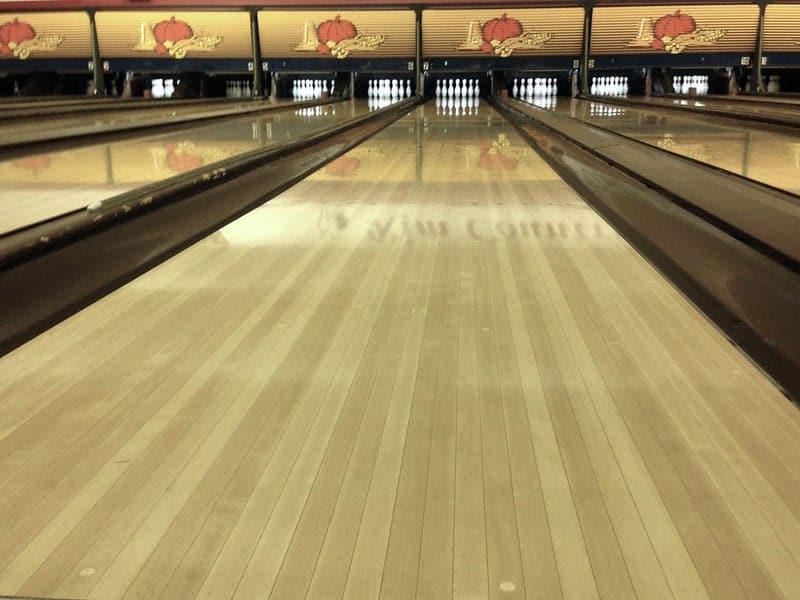
If you observe the bowling lane closer, you’ll notice that it comprises strips of wood that run vertically down the lane. These one-inch strips of wood are called the boards.
There should be a total of 39 boards for every lane. Each board corresponds to a number from 1 to 39. For right-handed players, they count from right to left. For left-handed players, they count from left to right.
Conditioner
You might hear the word, “conditioner,” and immediately think of the product you apply to your hair. However, in bowling terms, conditioner actually refers to lane oil. Conditioner acts as a protective coating on top of the lane. This prevents burn marks that can come from the force of thrown balls. Conditioner also helps lubricate the lane. This ensures that the ball rolls down the lane smoothly.
Dots
Near the foul line, you’ll notice several spots before the arrows. These marks are referred to as dots. These dots act as markers for the player to know where they should align their feet. When a player makes their approach, they often use the dots as their guide. That way, they do not make an approach off-center.
Dry
In bowling terms, dry refers to lanes with little conditioner. Professional players can easily tell a dry lane from an oiled lane. A dry lane will usually cause a ball to hook more than usual. Knowing this, the seasoned bowler will most likely adjust their throw to best score a strike.
Foul Line
The foul line is one of the most important things to be wary of when bowling. At the start of the lane, you’ll notice a line on the floor. This is called the foul line. The foul line represents the farthest point a player can approach.
If your foot accidentally crosses the foul line, your score will be zero pins. In case any pins were knocked down during this fault, then the pins will be reset before you throw your second ball. To avoid wasting a throw, be sure to be mindful of your approach.
Kickbacks
In a bowling alley, you’ll notice sideboards around the pins. People refer to these as kickbacks. They separate lanes from one another. They also act as a surface where pins can rebound when hit. When pins rebound against kickbacks, they often knock down more pins. This results in a higher score.
Learning about bowling terms like kickbacks can help you take advantage of the different parts of the lane.
Lane
Some bowling terms are self-explanatory. Lane, for instance, is easy enough to understand. A lane refers to the floor or playing surface where you throw your ball onto. From the foul line to the headpin, the lane is around 60 ft. long. Its width is 42 inches. However, people usually measure lanes according to the number of boards instead of inches.
Mid Lane
As the name suggests, the mid lane refers to the middle area of the lane. This is the surface between the arrows at the start of the lane and the back end.
Pin Deck
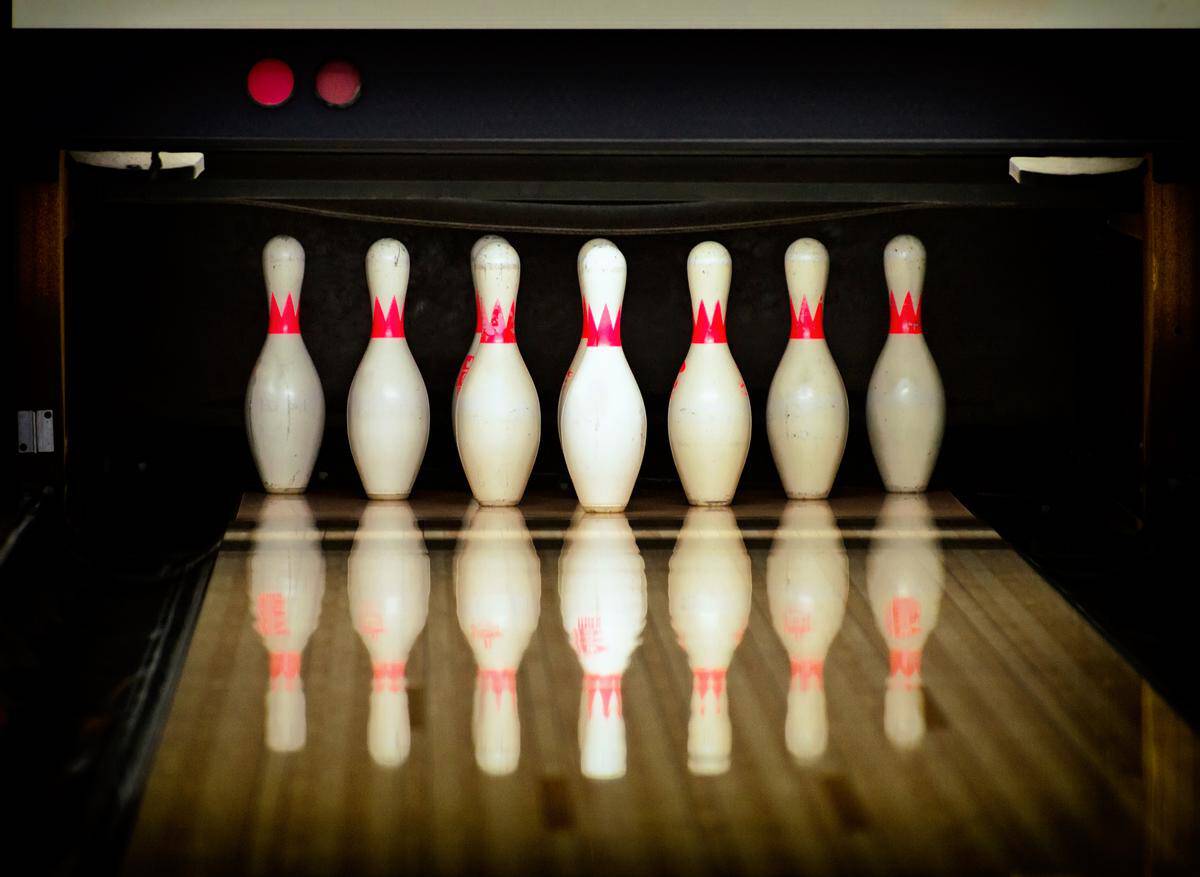
A deck can often refer to many things, such as a deck of cards or a part of a ship. In bowling terms, a deck or pin deck refers to the area where the bowling pins stand. This is also where bowling pins are reracked.
Pit
Behind the pin deck is the pit. This means that every lane ends with a pit. Bowling pins that get knocked over fall into the pit. From there, a mechanism collects the fallen pins and reracks them again on the pin deck.
Bowling Scoring Terms
The bowling terms for scoring differ from other sports. For casual players, these terms aren’t necessary to learn. However, it wouldn’t hurt to learn a few to get a head start! If you’re an aspiring bowler, then learning scoring terms is also important.
Bagger
In bowling terms, a bagger refers to a string of consecutive strikes by one player. To specify the score, players attach a number before the word. For instance, a four-bagger refers to four consecutive strikes. A five-bagger refers to five strikes in a row, and so on.
Chop

Imagine knocking over eight pins during your first throw. During your second throw, you aim to score a spare, where you knock over the last two remaining pins. Unfortunately, you only knock over one, leaving behind one upright pin. Players call this a “chop.”
A chop occurs when a player aims for a spare but is unsuccessful in knocking down all pins. It is important to note that a chop can also occur even if there are more than two remaining pins. As long as there are at least two pins during the player’s second throw, then a chop can happen when one or more remaining pins remain standing.
Count
In bowling terms, pin count, or simply count, is the number of pins a player knocks down from a single throw. Usually, this refers to the pins that toppled over in the first throw.
The pin count acts as a reference for the next frame when the player scores a spare or strike. For example, if a player hits a spare or strike, then their pin count is doubled in the final score. If a player scores two consecutive strikes, then their pin count is tripled in the scoring.
Foul
There are plenty of ways for players to commit fouls in other sports. For instance, basketball and volleyball players can commit different types of fouls, such as blocking and offensive fouls.
In bowling, a player commits a foul when their foot touches or crosses the foul line. This happens often for newbie players who haven’t perfected their approach yet.
A foul results in a score of zero for the player’s throw. However, if it is only the player’s first throw, they still have a chance to earn some points with the second throw.
Frame
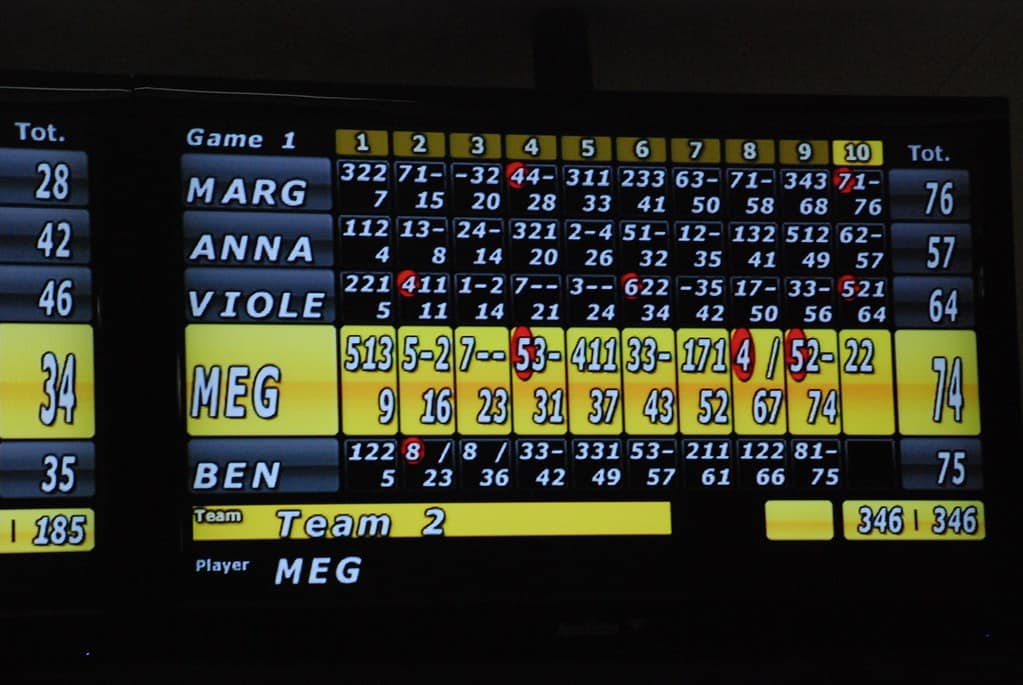
In bowling terms, a frame refers to a player’s turn. If you look at your scorecard, you’ll notice ten boxes lined up in a row. This represents the number of turns you have as a player.
A player will have a total of ten frames for a single match. For each frame, a player has a total of two throws except for the tenth frame. In the tenth frame, the player usually has two or three.
Handicap
To even out the playing field a little, players usually apply a handicap. In bowling terms, a handicap refers to a number added to the initial scores of both players, resulting in a “handicap score.”
Before the game starts, players will decide on a handicap to add at the end of the match. The purpose of a handicap is for less seasoned bowlers to have a handicap score closer to that of a seasoned bowler’s handicap score. With a handicap, a beginner is encouraged to win while the more experienced player is equally challenged.
Minus
In bowling terms, a “minus” works similarly to the mathematical function. During competitive plays, people will refer to a player’s score as the number of pins a bowler hits below a 200 average. For instance, if a player scores a total of 1,579, then their score is minus 21.
Open Frame
When a player doesn’t score a strike or spare during their turn, their frame becomes an “open frame.” In other words, if pins are remaining standing after two throws, then the player’s turn resulted in an open frame.
Some simply call this “open.”
Over
Over is one of the bowling terms that most casual bowlers probably aren’t familiar with. In bowling, over refers to the number of pins a player hits above a 200 score. In a way, it is the opposite of minus. This is how professional bowlers often refer to their scores. For instance, a player who scores a 218 score is “18 over.”
Par
In bowling terms, a par refers to a 200 game. It can also refer to a 200 score. For instance, if a player scores 176 in a 200 game, then they are “under par.” Usually, only professional bowlers use this scoring term.
Punch Out
When a player ends a game with consecutive strikes, they achieve a punch out. The consecutive strikes can occur at any point of the game as long as it continues until the end. This means that whether a player starts their streak of strikes on their fifth or eighth frame, they successfully delivered a punch out.
Sandbagging
For bowling terms that often cause disputes among players, sandbagging is one example. Sandbagging refers to purposely aiming for a lower average score to get a higher handicap. A person who does this is called a “sandbagger.”
Most players do not encourage sandbagging. They believe that sandbagging defeats the purpose of a handicap, which is to even out the playing field while keeping things challenging.
Scratch
A scratch, or scratch score, refers to the player’s raw score after a match. This is the actual number of pins that the player manages to knock over during the match. To get the player’s handicap score, they add the handicap to the scratch.
Six-Pack
In fitness, a six-pack refers to abs that are so well-defined that they appear to have “six packs.” In bowling terms, a six-pack refers to six consecutive strikes by one player. Scoring a strike is no easy feat, so six strikes in a row is surely a difficult goal. However, if you’re looking to challenge yourself, why not try to aim for a six-pack next time you find yourself in the bowling alley?
Tap
A perfect roll might not always lead to a strike. Sometimes, a player makes a perfect throw, and everybody expects for it to land a strike. However, only nine pins are knocked down, and one pin remains standing. People call this occurrence a tap.
Turkey
A turkey doesn’t always refer to the animal. In bowling terms, it actually refers to three consecutive strikes. If a player manages to hit three strikes in a row during a single match, then they achieved a turkey.
Vacancy
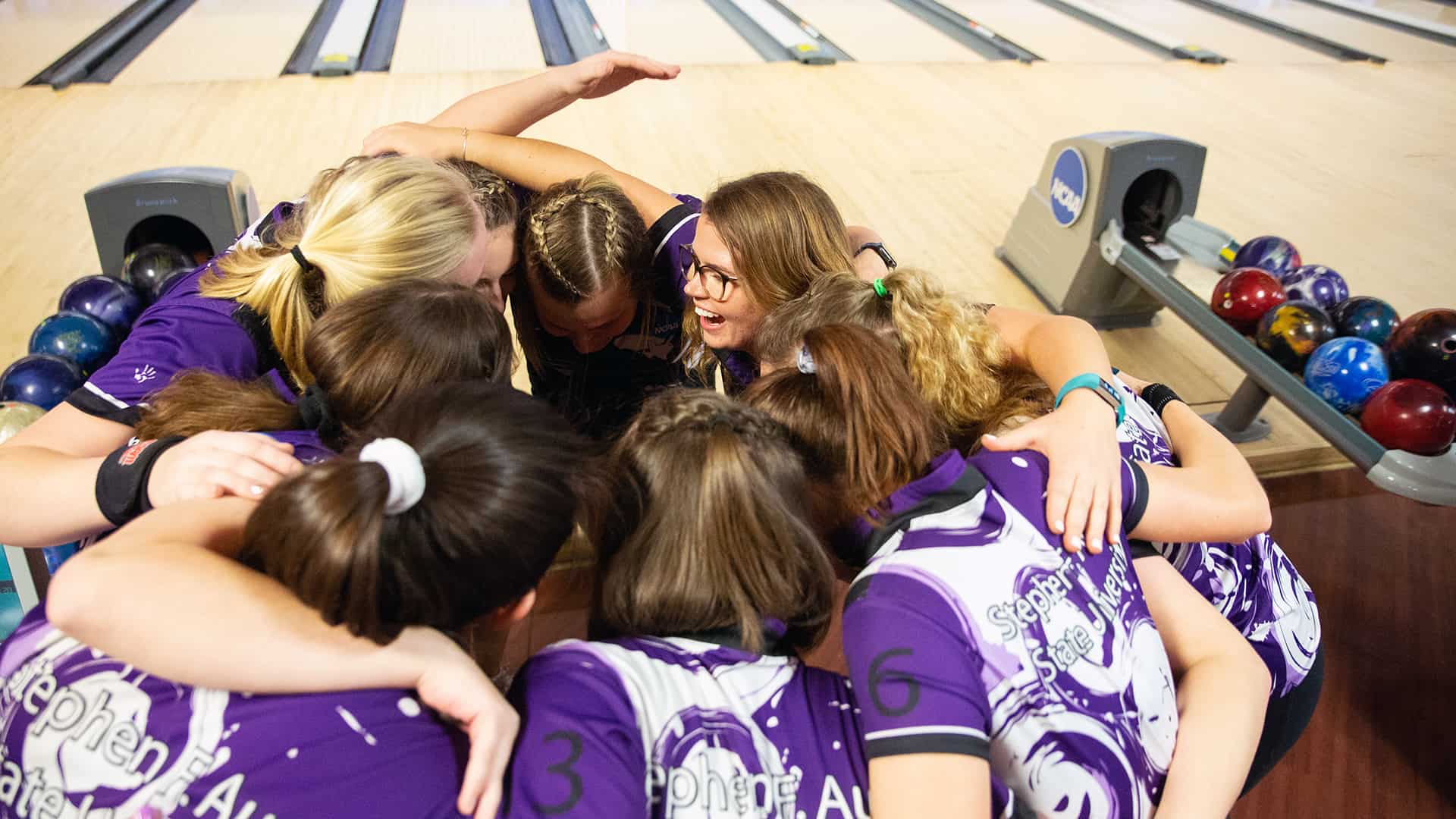
During league plays, not all teams will have the same number of members. Some big teams will compete with those who have fewer members. When this happens, the league will use a dummy or fake score. This is called a vacancy score. It fills in the score of the vacant position in the team roster. The league assigns the vacancy score to ensure that it is fair for all teams.
Strike Out
In baseball terms, a strikeout occurs when a batter scores three strikes. When a strikeout happens, the referee sends the batter out of the strike zone. In bowling terms, however, a strikeout is actually a good thing!
A strikeout in bowling happens when a player finishes the game with three strikes. This means that they performed three strikes during their tenth frame.
Bowling Gameplay and Strategy Terms
With basic terms, scoring, and equipment out of the way, it is finally time to learn the terms for gameplay and strategy. This also includes some slang terms that players use among themselves.
Address
The first thing people think of when they hear “address” is the location of their home. In bowling terms, however, an address refers to the player’s starting stance. This is how they stand before they approach the lane for their throw.
A player’s address is important as it helps them prepare for their approach. A poor address will probably lead to a poor approach and cause a poor throw. For a perfect throw, it is important to get one’s address and approach right.
Action
Action refers to the movement of the pins after the player hits them with their thrown ball. When pins jump, fly, or bump against each other, these are all actions. Action can also refer to the spin of the bowling ball and the resulting movement once it hits the pins.
Some people also use action to refer to “action bowling.” This is a type of bowling that involves money betting. It is usually a one-on-one match. Action bowling was very popular in the 1940s up to the 1970s, especially in New York.
Anchor
In competitive bowling, teams will have an anchor. An anchor is the last player from the team to play. Usually, teams will reserve this slot for their best bowler. This is a strategy that teams like to use to end the game with strikes.
Bad Rack
Similar to billiards, a bad rack can also happen in bowling. Players call a set of pins a bad rack even if only one of the pins is not in the proper position. A bad rack can affect a player’s throw. This is why players will often check the pins to make sure they are in their proper positions.
Bucket
Another example of gameplay bowling terms is the bucket. A bucket refers to a diamond-shaped set of four pins. For example, pins 1, 2, 3, and 5 make a diamond. Pins 2, 4, 5, and 8 also form a diamond together.
Double Wood
A double wood refers to two pins where one pin stands behind the other. This can be any combination of pins, so long as one of them is directly behind another pin. For example, the combination of pins 2 and 8 is a double wood. Other examples include 3-9 and 1-5.
Fast Eight
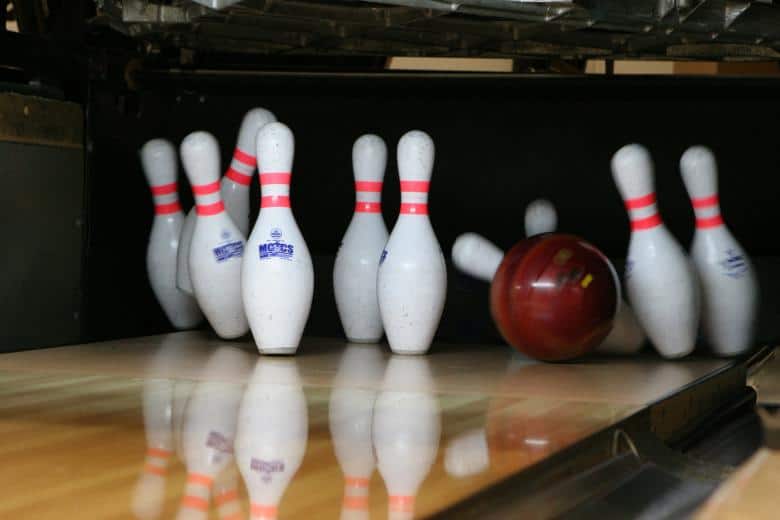
A fast eight occurs when a player successfully knocks over eight pins with one throw. Players consider a fast eight a good hit when they leave behind two pins that they can easily knock over to score a spare. For right-handed players, they usually aim to leave pins 4 and 7 upright. For left-handed players, they aim for pins 6 and 10. These combinations are easy to knock over in the second throw.
Greek Church
In bowling, a Greek church refers to a split with three pins remaining standing on one side and two pins on the other side. One example is when a player’s throw leaves pins 4, 7, and 8 standing on the left side with pins 6 and 10 also upright on the right side.
The name comes from the way the remaining pins resemble the five spires of a Greek Orthodox church.
High Hit
A high hit occurs when a player’s throw ends up hitting too much of the headpin. This usually happens when the player aims for a strike but is unsuccessful, leaving behind a few pins still upright.
Some also use this to refer to a hard hit against the center portion of a pin.
Hook
A hook is one of the bowling terms that players first learn about in their training. A hook is when the ball suddenly curves before rolling to hit a pin. Usually, a ball hooks in the back end. A ball’s hook will depend on the spin a player adds to the ball during their throw.
The maximum change in ball direction happens during the hook, so you’ll easily notice this when watching a bowling game.
Leave
In bowling terms, leave refers to the remaining number of pins after a player’s first throw in a frame. This does not include the pins that remain upright after the second throw. For example, if a player’s first throw results in five pins left standing, then the player has a “5-pin leave.”
Light Hit
A player makes a light hit when their thrown ball only hits the side of a pin. When this happens, the pin usually moves sideways. This is usually accidental as a light hit is not effective in knocking down as many pins as possible.
Another term for a light hit is a low hit.
Loft
Loft is one of the bowling terms for common beginner mistakes. In bowling, it is important to get the timing of your throw right. When the timing is a bit off, lofting can occur. For instance, throwing the ball beyond the foul line can cause lofting. The ball hits the lane hard instead of rolling smoothly from your grip to the lane.
Messenger
A messenger is more than just Facebook’s messaging app. In bowling terms, a messenger refers to a pin that travels across the pin deck to knock down other pins. In a way, the pin acts as a messenger that delivers force against other pins. This is a great way to achieve a spare when faced with a split.
Revolutions
Just like how the earth revolves around the sun, a bowling ball also has its own revolutions. A revolution in bowling terms refers to the number of turns a bowling ball makes. A ball’s revolution count starts from its release to the moment it hits a pin. In general, more revolutions result in a better outcome.
Straight Ball
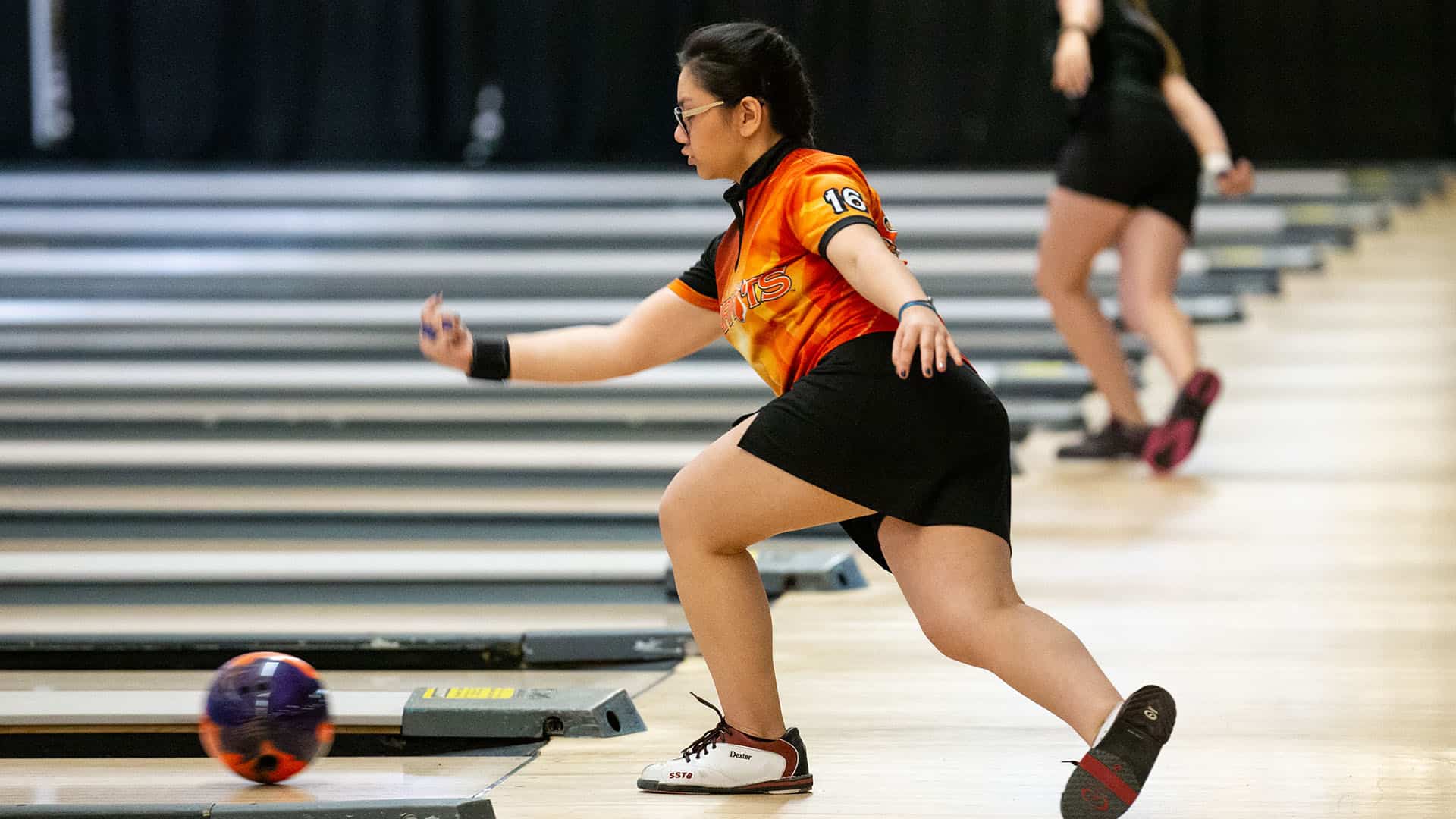
The straight ball is another example of self-explanatory bowling terms. A player throws a straight ball when the ball travels straight down the lane. This means the ball does not hook or change direction at any point.
For players who like to throw straight balls, they favor using polyester or plastic bowling balls. This is because these types of balls have low hook potential.
Split
Split is a general term for a leave with at least two non-adjacent pins still standing. In a split, the head pin is not included as it should already be knocked over. One example of a split is a 9-10 leave, where pins 9 and 10 remain standing but with a gap between them. On the other hand, a 3-6 leave is not a split because the two pins are adjacent.
Spot Bowling
Remember the different marks on the lane, such as the arrows, dots, and boards? These marks all come in handy during spot bowling. Spot bowling refers to bowling while aiming at a specific spot on the lane. This specific spot can be a board or arrow.
For instance, a player locks on the arrows on the lane. While visually focusing on these arrows, the player aims their throw toward them. In doing this, the player does spot bowling.
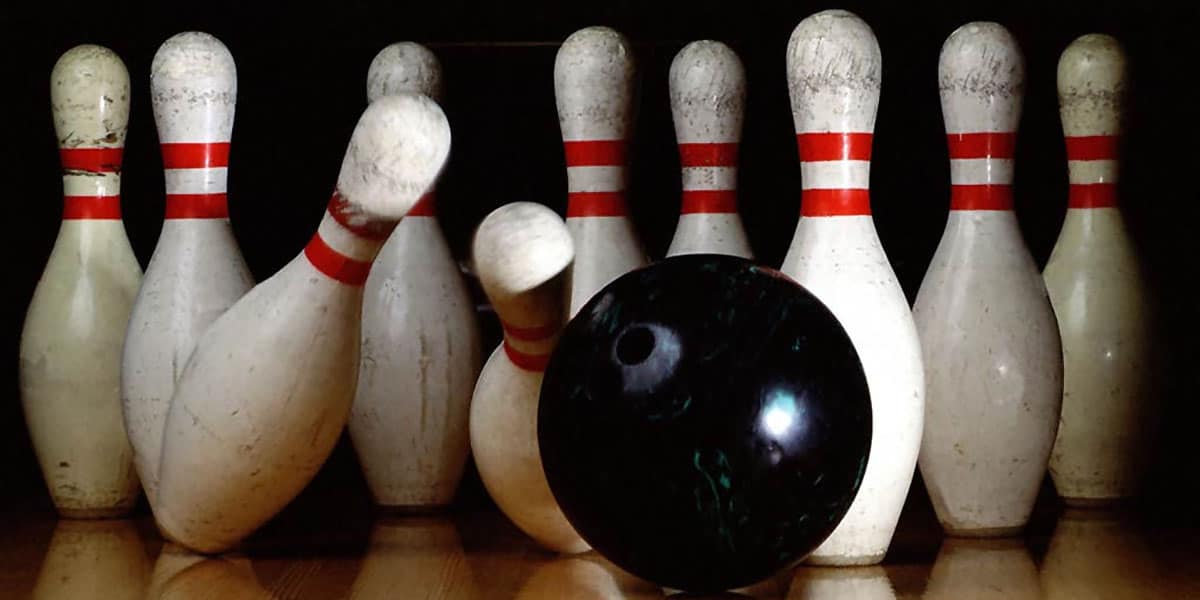
If you want to score a strike, the best place to aim your throw at is the pocket. The pocket refers to the space in between the head pin and the pin beside it. Hitting this area has the best chance of scoring a strike.
There are a total of two pockets. For right-handed players, the pocket is in between pins 1 and 3. For left-handed players, the pocket is in between pins 1 and 2.
Wall Shot
Last on this list of bowling terms is the wall shot. A wall shot refers to a strike where pins, especially the headpin, bounce off the side walls. This usually results from a light pocket hit.
Was this page helpful?
Our commitment to delivering trustworthy and engaging content is at the heart of what we do. Each fact on our site is contributed by real users like you, bringing a wealth of diverse insights and information. To ensure the highest standards of accuracy and reliability, our dedicated editors meticulously review each submission. This process guarantees that the facts we share are not only fascinating but also credible. Trust in our commitment to quality and authenticity as you explore and learn with us.
